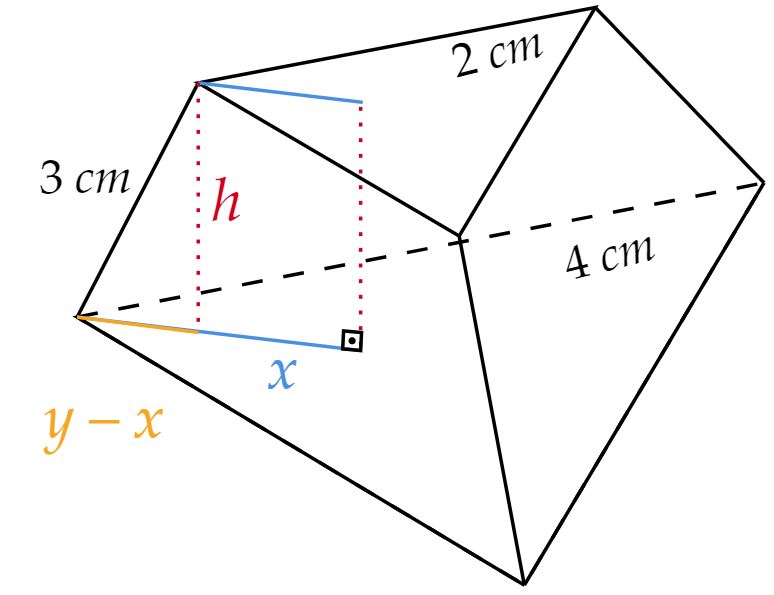Um tronco de pirâmide regular tem como bases triângulos equiláteros, cujos lados medem, respectivamente, e . Se a aresta lateral do tronco mede , então o valor de sua altura , em , é tal que:
CossenoGPT
Teste
gratuitamente agora
mesmo! 

A priori, sabe-se que é um tronco de pirâmide regular, logo, suas respectivas bases são regulares, ou seja, triângulos equiláteros. Nesse viés, observe a figura abaixo:
 Com isso, entende-se que o baricentro divide o triângulo numa razão $1:2$, assim, se a altura do triângulo for $t$, têm-se: \begin{matrix} t_1 = {{\dfrac{2\sqrt{3}}{2}}} &,& x = {{\dfrac{2}{3}}} \cdot t_1 &\therefore& x = {{\dfrac{2\sqrt{3}}{3}}} \\ \\ t_2 = {{\dfrac{4\sqrt{3}}{2}}} &,& y = {{\dfrac{2}{3}}} \cdot t_2 &\therefore& y = {{\dfrac{4\sqrt{3}}{3}}}
\end{matrix}Por Pitágoras, constata-se: \begin{matrix} 3^2 = (y-x)^2 + h^2 &\Rightarrow& h = \sqrt{\dfrac{23}{3}}&\therefore& h = \sqrt{7,\overline{6}}
\end{matrix} Portanto: \begin{matrix} \sqrt{7}< h < \sqrt{8} \\ \\ Letra \ (A)
\end{matrix}
Com isso, entende-se que o baricentro divide o triângulo numa razão $1:2$, assim, se a altura do triângulo for $t$, têm-se: \begin{matrix} t_1 = {{\dfrac{2\sqrt{3}}{2}}} &,& x = {{\dfrac{2}{3}}} \cdot t_1 &\therefore& x = {{\dfrac{2\sqrt{3}}{3}}} \\ \\ t_2 = {{\dfrac{4\sqrt{3}}{2}}} &,& y = {{\dfrac{2}{3}}} \cdot t_2 &\therefore& y = {{\dfrac{4\sqrt{3}}{3}}}
\end{matrix}Por Pitágoras, constata-se: \begin{matrix} 3^2 = (y-x)^2 + h^2 &\Rightarrow& h = \sqrt{\dfrac{23}{3}}&\therefore& h = \sqrt{7,\overline{6}}
\end{matrix} Portanto: \begin{matrix} \sqrt{7}< h < \sqrt{8} \\ \\ Letra \ (A)
\end{matrix}

Ampliar Imagem

01:17 01/06/2023
A altura do triângulo equilátero não é definida por L√3/2? Sendo assim, x e y seriam, respectivamente, 2√3/3 e 4√3/3 e a resposta certa seria a letra C

